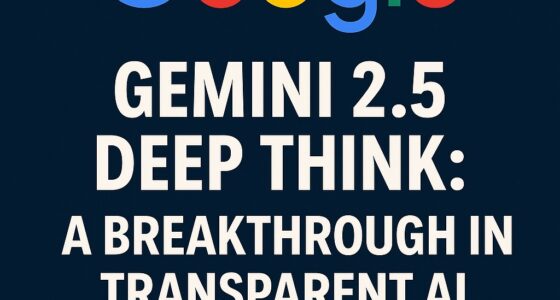AI automation has a significant carbon footprint because training large models and maintaining data centers require a lot of energy, often from fossil fuels. This high energy use leads to substantial emissions that contribute to climate change. Regions depending on dirty energy sources see even bigger impacts. While efforts are underway to develop greener infrastructure and more efficient algorithms, understanding the true environmental cost helps you see why responsible practices matter. Learn more to see how you can make a difference.
Key Takeaways
- Training large AI models consumes substantial energy, often comparable to the emissions of several cars over a lifetime.
- Data centers powering AI require continuous operation, cooling, and hardware maintenance, increasing carbon emissions.
- Reliance on fossil fuel energy sources amplifies AI’s environmental footprint globally.
- Developing energy-efficient AI hardware and algorithms can significantly reduce the carbon cost.
- Transitioning to renewable energy sources for data centers is essential to mitigate AI’s environmental impact.

Have you ever wondered what it truly costs to power AI automation? Behind the impressive capabilities of AI systems lies a significant environmental footprint. Training large AI models requires enormous computational resources, which in turn demand vast amounts of energy. This energy consumption contributes directly to carbon emissions, especially if the electricity comes from fossil fuels. As AI becomes more integrated into daily life, understanding its true environmental impact is vital.
Powering AI automation leaves a significant environmental footprint through energy-consuming processes and carbon emissions.
The process of developing and deploying AI involves complex calculations and data processing across massive server farms. These data centers operate nonstop, consuming tremendous power to run hardware, cool equipment, and maintain connectivity. The more advanced the AI, the more energy it typically needs. For example, training a single sophisticated model can emit as much carbon as several cars over their lifetimes. This isn’t just a theoretical concern—it’s a practical reality that adds to global emissions, especially in regions relying heavily on coal and other fossil fuels.
Moreover, the infrastructure supporting AI isn’t static. As demand grows, more data centers are built, and existing facilities expand. This expansion amplifies the carbon footprint, often without immediate awareness from users. While companies may improve energy efficiency over time, the overall energy demand continues to rise. The lifecycle of AI hardware, from manufacturing to disposal, also involves carbon costs, further adding to environmental concerns. Investments in greener infrastructure can help mitigate these impacts. Additionally, the development of more energy-efficient hardware can significantly reduce the overall carbon footprint.
You might think that the technology will eventually become more sustainable, and there are efforts toward greener AI. However, current progress is slow compared to the rapid growth of AI applications. If you’re concerned about climate change, it’s essential to recognize that powering AI isn’t just about algorithms and data—it’s about the energy that fuels them. Shifting to renewable energy sources can mitigate some impacts, but the shift isn’t yet universal or complete.
Understanding the carbon cost of AI means acknowledging that every calculation, every data transfer, and every model training session has a footprint. As an AI user or developer, you can advocate for greener practices, support policies that promote renewable energy, and push for more energy-efficient algorithms. Recognizing this hidden cost helps us make more informed choices about how we develop and deploy AI technology. Ultimately, balancing innovation with sustainability requires transparency about the environmental impact and a commitment to reducing it wherever possible.
Frequently Asked Questions
How Does AI Energy Consumption Compare to Traditional Manufacturing Processes?
You might think AI uses less energy than manufacturing, but it actually consumes much more per task. AI data centers require 7 to 8 times the energy of traditional computing workloads, and their growth outpaces industrial energy use. By 2030, AI will profoundly increase global electricity demand, especially in data centers, and strain power grids. So, instead of being more efficient, AI’s energy footprint is growing rapidly and surpassing many manufacturing processes.
What Are the Long-Term Environmental Impacts of Widespread AI Deployment?
Your future with AI is like walking a tightrope over an expanding chasm of environmental harm. Widespread AI deployment risks tripling emissions, depleting water resources, and generating mountains of e-waste. You could see ecosystems disrupted, water shortages worsen, and local communities suffer from pollution and resource strain. Without careful management, AI’s long-term environmental impact may threaten the very world it aims to transform, turning progress into a potential ecological crisis.
Can AI Algorithms Be Optimized for Lower Carbon Footprints?
You can optimize AI algorithms for lower carbon footprints by focusing on energy efficiency techniques like quantization and knowledge distillation, which compress models without losing performance. Using efficient neural networks, dynamic energy management, and input-specific optimization helps reduce emissions. Additionally, implementing renewable-powered data centers, smart grid integration, and AI-driven process improvements further cuts energy use and emissions, making AI deployment more sustainable over the long term.
How Do Data Center Locations Influence Ai’s Overall Carbon Emissions?
Your data center’s location directly impacts AI’s carbon emissions. If your data center is in a region with a clean, renewable-heavy grid, your AI operations produce fewer emissions. Conversely, if it’s in a fossil-fuel-dependent area, emissions increase. Water availability, cooling needs, and regional policies also matter. Choosing locations with low-carbon energy, water-efficient cooling, and supportive policies helps reduce AI’s overall carbon footprint.
What Policies Can Effectively Reduce Ai’s Environmental Impact Globally?
You should know that implementing energy-aware policies can drastically cut AI’s environmental impact. For example, AI data centers now consume enough power to power entire cities, but mandating 100% renewable energy and offering tax incentives for efficient algorithms can lower emissions considerably. Enforcing transparency, like emission labeling, helps hold providers accountable. These strategies, combined, can lead to smarter, cleaner AI development, reducing global carbon footprints and conserving water and resources.
Conclusion
Remember, every action has a cost, and AI automation is no exception. While it promises efficiency and progress, it also leaves a carbon footprint behind. By understanding the true environmental impact, you can make smarter choices and advocate for greener solutions. Don’t forget, “We don’t inherit the earth from our ancestors, we borrow it from our children.” Stay mindful of your role in reducing AI’s carbon footprint—every small step counts toward a healthier planet.









